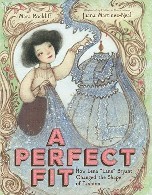Parrots, Pugs, and Pixie Dust is the story of designer Judith Leiber’s life and her unique creations. Born into a Jewish family in Hungary in 1921, Judith Peto survived the Holocaust making army uniforms under harsh conditions. After the war, she married American G.I. Gerson Leiber; they died on the same day in 2018. During their years together, the couple established a company producing Leiber’s sought-after designs for pocketbooks in every form imaginable, including animals, food, and works of architecture. The author and illustrator have created a biography well-matched to Leiber’s personal artistic vision, integrating the events of her life and her determination to pursue beauty in spite of all she had suffered.
Deborah Blumenthal’s text avoids trite conclusions about the surface ironies of Leiber’s style; a woman who had endured violent antisemitism and forced labor decided to specialize in glittering objects priced for celebrities. The book’s language is both poetic and accessible; children will be fascinated by Masha D’Yans’ pointillist pastel images of “preening peacocks” and “fanciful frogs donning gilded crowns, pandas, poodles, parrots, pugs.” Blumenthal acknowledges the reader’s expectation that these must be the work of a Cinderella or a queen, even if that queen is a gray-haired Jewish woman wearing oversized glasses. The ensuing description of Leiber’s young life quickly transforms her into a real person. Readers learn that Leiber was highly imaginative and artistic but her future was threatened by world events. There are no generalities here: “She grew up in Budapest, at a time when Jewish families like hers were treated cruelly, just because they were Jewish.”
After safely studying chemistry in London, Leiber returns to her home just as World War II begins, a choice which could have ended her life as the persecution of Jews intensified. D’Yans’ versatility as an illustrator shines as the pictures of glorious miniatures floating against a white page become dark scenes of oppression. War planes circle as Leiber sweeps floors in the handbag company where she is learning her trade. As many Jews are deported by the Nazis, Leiber and her family are spared because of their skills, but the pictures show increasingly dark and claustrophobic scenes, ending in the basement where they are forced to hide. Leiber’s liberation returns the pictures to their earlier delicate colors as she meets her husband and begins to focus on the imaginative accessories for which she became famous.
Although Blumenthal refrains from making Leiber’s life into an object lesson about optimism and perseverance, she does refer to the designer’s awareness of the role of luck in her survival and to her subsequent celebration of life and beauty. In a detailed “Author’s Note,” Blumenthal provides further information, as well as interpretation of Leiber’s signature style: the high quality she insisted on for her beautiful objects, her total immersion in work, and her creativity as a refuge from oppression were all implicit messages in her handbags. This brief biography brings out those messages in the context of her remarkable life.
This highly recommended biography is suitable for the older end of the recommended range as well as for adults.
Emily Schneider writes about literature, feminism, and culture for Tablet, The Forward, The Horn Book, and other publications, and writes about children’s books on her blog. She has a Ph.D. in Romance Languages and Literatures.





